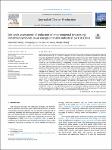Thông tin tài liệu
Thông tin siêu dữ liệu biểu ghi
| Trường DC | Giá trị | Ngôn ngữ |
|---|---|---|
| dc.contributor.author | Wang, Shanshan | vi |
| dc.contributor.other | Lu, Chunyang | vi |
| dc.contributor.other | Gao, Yu | vi |
| dc.contributor.other | Wang, Ke | vi |
| dc.contributor.other | Zhang, Ruiqin | vi |
| dc.date.accessioned | 2020-04-07T01:25:33Z | - |
| dc.date.available | 2020-04-07T01:25:33Z | - |
| dc.date.issued | 2019 | - |
| dc.identifier.issn | 0959-6526 | vi |
| dc.identifier.uri | http://tailieuso.tlu.edu.vn/handle/DHTL/8375 | - |
| dc.description.abstract | Abstract: Industrial symbiosis (IS) is a collective approach to attain competitive advantage through the physical exchanges of materials, energy, water, and by-products, especially for the energy-intensive industrial parks. To highlight the reduction of potential environmental impacts of IS in a more complicated system, the extent of synergistic interactions among different industries, including power plants, aluminum, chemicals, iron and steel industries, in Yongcheng Economic Development Zone, Henan Province, China was explored. Specifically, a total of nine plants were used for IS analysis with thirteen IS links from the 2017 data. Different from the four environmental impact categories in previous studies, the reduction of potential environmental impacts through eight environmental impact categories adopting life cycle assessment method, including primary energy, greenhouse gas (GHG) emission, acidification potential, eutrophication potential, particulate matter (PM), human toxicity, respiratory inorganics, and ozone formation potential were evaluated, in addition to economic gains. The results show that effective impact reductions can be attained via thirteen symbiosis links, including 9456 TJ of primary energy, 850 kt CO2eq of GHG, 3297 t SO2eq of acidification, 242 t PO43−eq of eutrophication, 24 t PM10eq of particulate matter, 2529 t 1,4-dichlorobenzene-eq of human toxicity, 4087 t PM2.5eq of respiratory inorganics and 20.6 t C2H4eq of ozone formation potential. In addition, 958 million RMB (1 USD ≈ 6.7 RMB in 2017) could be saved, accounting for 5.5% of the total value added of the park in 2017. The greatest contribution is from steam exchange between the power plants, methanol/ethylene glycol chemical plant, and other enterprises. In total, IS is an important way to reduce environmental impacts and gain economic benefits in this energy-intensive industrial park. The government should speed up the promotion of IS and make it a feasible approach to more eco-efficient development in industrial parks. | vi |
| dc.language | en_US | vi |
| dc.publisher | Elsevier | vi |
| dc.relation.ispartofseries | Journal of Cleaner Production, Volume 241, 2019, 118358 | vi |
| dc.subject | Industrial symbiosis | vi |
| dc.subject | Life cycle assessment | vi |
| dc.subject | Environmental impact reduction potentials | vi |
| dc.subject | Energy saving | vi |
| dc.subject | Industrial park | vi |
| dc.title | Life cycle assessment of reduction of environmental impacts via industrial symbiosis in an energy-intensive industrial park in China | vi |
| dc.type | BB | vi |
| Trong bộ sưu tập: | Tài liệu hỗ trợ nghiên cứu khoa học | |
Danh sách tệp tin đính kèm:
Bạn đọc là cán bộ, giáo viên, sinh viên của Trường Đại học Thuỷ Lợi cần đăng nhập để Xem trực tuyến/Tải về
Khi sử dụng tài liệu trong thư viện số bạn đọc phải tuân thủ đầy đủ luật bản quyền.

